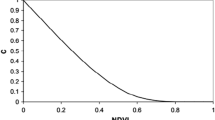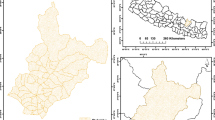Abstract
In northern Algeria, the physical degradation of land by water erosion is one of the most serious forms of degradation. As is well known, vegetation plays an important role against water erosion. In the mentioned area the potential vegetation called maquis is currently characterized by an advanced stated of degradation, often ranging between sparse cover and bare soil. In the Oued Fergoug watershed belonging to the Beni Chougrane Mountains (NW of Algeria), a trial was carried out with a mini rainfall simulator designed by ORSTOM to evaluate the runoff rate and the sediment load at experimental plot scale and in a situation of bare soil. The experimental layout took into account two different surface slopes, three different rainfall intensities, and three levels of initial soil water content. The highest runoff values observed exceeded 0.50 mm min−1 and the maximum sediment load yield was 94.2 g L−1 per square meter. Summarizing, the intensity of rain is the main factor for runoff generation, independently of the slope and the initial soil water content values. Since vegetation cover is a crucial component in maintaining stable slopes and limiting soil losses, the most effective practice to protect bare soil against erosion is to provide a protective ground plant cover in this area.
Similar content being viewed by others
References
Asseline J. 1981. Notice technique. Construction d’un infiltromètre à aspersion: ORSTOM Adiopodoumé, 26 pp.
Benchetrit M. 1966. Les modalités de la dégradation des foręts dans le Tell oranais. Revue de Géographie de Lyon 41: 303–338.
Bouchetata A. & Bouchetata T. 2006. Propositions d’aménagement du sous-bassin-versant de l’oued Fergoug (Algérie) fragilisé par des épisodes de sécheresse et soumis à l’érosion hydrique. Sécheresse 17: 415–424.
Casenave A. 1982. Le mini-simulateur de pluie: Conditions d’utilisation et principes de l’interprétation des mesures. Cah. ORSTOM, sér. Hydrol., XIX: 207–227.
Chaplot V.A.M. & Le Bissonnais Y. 2003. Runoff features for interrill erosion at different rainfall intensities, slope lengths, and gradients in an agricultural loessial hillslope. Soil Sci. Soc. Am. J. 67: 844–851.
Coppin N.J. & Richards I.G. (eds) 1990. Use of Vegetation in Civil Engineering, CIRIA/ Butterworths, London.
FAO. 2005. Utilisation des engrais par culture en Algérie. Organisation des Nations Unies pour l’alimentation et l’agriculture, Rome, Italie, 43 pp.
Gray D.H. & Sotir R.B. 1996. Biotechnical and Soil Bioengineering Slope Stabilization. A Practical Guide for Erosion Control. John Wiley and Sons, Inc., Toronto, Canada, 400 pp.
Haddouche I., Benhanifia K. & Gacemi M. 2011. Analyse spatiale de la régénération forestière post-incendie de la Fôret de Fergoug à Mascara, Algèrie. Bois et Foręts des Tropiques 307: 23–31.
Himmelbauer M.L., Vateva V., Lozanova L., Loiskandl W. & Rousseva S. 2013. Site effects on root characteristics and soil protection capability of two cover crops grown in South Bulgaria. J. Hydrol. Hydromech. 61: 30–38.
Koulouri M. & Giourga C. 2007. Land abandonment and slope gradient as key factors of soil erosion in Mediterranean terraced lands. Catena 69: 274–281.
Martínez Raya A., Durán Zuazo V.H. & Francia Martínez J.R. 2005. Soil erosion and runoff response to plant-cover strips on semiarid slopes (SE Spain). Land Degrad. Develop. 17: 1–11.
Martínez-Murillo J.F., Nadal-Romero E., Regüés D., Cerdà A. & Poesen J. 2013. Soil erosion and hydrology of the western Mediterranean badlands throughout rainfall simulation experiments: A review. Catena 106: 101–112.
Minitab Inc. 2012. Minitab Statistical Software Version 17.2.1. Minitab Inc., State College, PA. URL http://www.minitab.com/.
Prinz D., Gomer D. & Belz S. 1994. Studies of the causes of soil erosion on marl soils in Northern Algeria: The role of traditional soil tillage. Land Degrad. Rehabil. 5: 271–280.
Puigdefabregas J., Del Barrio G. & Hill J. 2009. Ecosystemic approaches to land degradation. Invited lectured. International Conference on Desertification. Department of Geography. University of Murcia (Spain), pp. 77–84.
Rey F., Ballais J-L., Marre A. & Rovéra G. 2004. Rôle de la végétation dans la protection contre l’érosion hydrique de surface. Compt. Rend. Géosci. 336: 991–998.
Rickson R.J. & Morgan R.P.C. 1995. Introduction, pp. 1–3. In:Morgan R.P.C. & Rickson R.J. (eds), Slope Stabilization and Erosion Control: A Bioengineering Approach, Chapman & Hall.
Souidi Z., Hamimed A. & Donze F. 2014. Cartographie du risque de dégradation des terres en région semi-aride. Cas des Monts de Beni Chougrane dans le Tell occidental algérien. Geo-Eco-Trop 38: 85–102.
Tayeb T.S. & Kheloufi B. 2014. Land cover dynamics in Beni Chougrane Mountains, north west of Algeria, using remote sensing. J. Basic Appl. Sci. 10: 257–266.
Zahira S., Abderrahmane H., Mederbal K. & Frederic D. 2009. Mapping latent heat flux in theWestern forest covered regions of Algeria using remote sensing data and a spatialized model. Remote Sensing 1: 795–817.
Zdruli P. 2014. Land resources, population growth and Mediterranean region development: Pressures, trends and impacts of future regional development. Land Degrad. Develop. 25: 373–384.
Author information
Authors and Affiliations
Corresponding author
Rights and permissions
About this article
Cite this article
Boukhari, Y., Ginovart, M., Verdú, A.M.C. et al. Hydrological soil behavior in areas with semi-arid vegetation (Beni Chougrane Mountains, Algeria). Biologia 71, 1131–1136 (2016). https://doi.org/10.1515/biolog-2016-0132
Received:
Accepted:
Published:
Issue Date:
DOI: https://doi.org/10.1515/biolog-2016-0132




